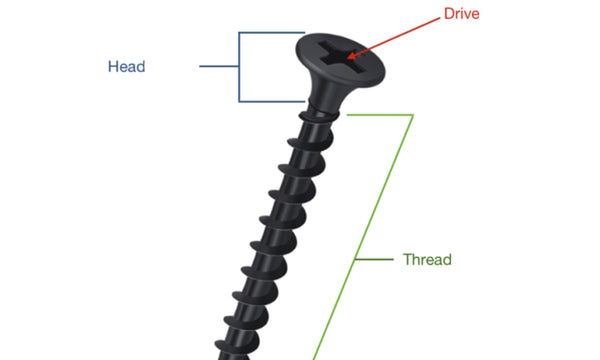Award Winning Service
Award Winning Service


Starting a drywall project may seem straightforward, but the devil is in the details, particularly when it comes to choosing the right drywall screws. Using the incorrect type of screw could compromise the integrity of your gypsum board installation. This comprehensive guide aims to arm you with the essential knowledge you'll need to make an informed choice.
The thread design plays a vital role in holding your sheetrock in place. Coarse-threaded screws are better suited for attaching drywall to wood studs, while fine-threaded screws are ideal for metal studs. The design impacts how the screw grips the material, thereby affecting the overall stability of the drywall installation.
The length of the screw is equally important. A general rule is to choose a screw length that will penetrate the stud by at least 1/2 inch. However, this varies depending on the thickness of your gypsum board and the material of the stud. Always double-check the specifications to ensure you’re using the right length.
Stainless steel, zinc, and phosphated screws are among the popular choices. Stainless steel offers high resistance against rust, making it suitable for areas with high humidity. Phosphated screws, on the other hand, are designed to hold paint better, giving you a cleaner finished look.

These screws are primarily used for attaching drywall to wooden studs. The coarse thread offers an excellent grip, anchoring the gypsum board firmly to the wood.
These are best suited for attaching drywall to metal studs. Metal studs are typically seen in commercial buildings and require screws that can secure the sheetrock without compromising the metal's integrity.
For those who don't want to pre-drill holes, self-drilling screws come with a drill point, making them convenient and time-saving.
These are used primarily for attaching wood trim over drywall. The small, flat head makes it easy to conceal, ensuring that the focus stays on your beautifully finished walls.
For any significant drywall project, a drywall drill is essential. These drills are designed to provide the torque you need for rapid, efficient installation, making them preferable over regular drills.
A drywall dimpler is a fantastic tool for novices and experts alike. This simple attachment for your drill ensures that every screw is set at the correct depth, reducing the likelihood of surface cracks or paper tearing.
For the most common drywall thickness of 1/2-inch, 1 1/4-inch screws are generally suitable when attaching it to wooden studs. However, when working with metal studs, you might want to consider 1-inch screws to avoid damaging the metal.
This thickness is often used for ceilings or commercial buildings. In such cases, screws that are 1 5/8-inches are commonly recommended. Again, if you're dealing with metal studs, you might want to scale down to a 1 1/4-inch screw.
These thinner drywall options generally require shorter screws. A 1-inch screw should be more than adequate for securing this type of drywall to either wood or metal studs.
Before you begin, make sure the wall is clean and free from debris. This ensures that the screws hold well and provide maximum support.
When installing, ensure that screws are spaced evenly—approximately every 12 inches along the stud is standard practice. This ensures that the drywall is securely attached and won’t sag over time.
Personal safety is crucial when undertaking any construction project. Always wear appropriate gear like safety goggles and gloves. Make sure your tools are in good working condition to avoid accidents.
Armed with this comprehensive guide, the task of choosing the right drywall screws for your gypsum board project should now seem far less daunting. Always remember, the quality of your project starts with the quality of your materials and tools.
Drywall screws are specialized types of fasteners designed explicitly for drywall or gypsum board installations. Unlike regular screws, they are created to offer superior holding power, ensuring that your sheetrock stays firmly attached to either wood or metal studs.
While not strictly mandatory, a drywall drill offers specialized benefits, making the task significantly easier and more efficient. A drywall drill, sometimes known as a drywall screw gun, provides the correct amount of torque and speed required to drive screws into various types of studs securely. For a quicker and more effective installation, investing in a drywall screw gun is highly recommended.
A drywall dimpler is an attachment for your drill that helps to set the drywall screws at the ideal depth in the gypsum board. The drywall dimpler prevents you from drilling the screws too deep, which can lead to surface cracks or tearing of the drywall paper. It's a handy tool for both novices and professionals aiming for a flawless finish.
The appropriate length of your drywall screws depends on the thickness of your gypsum board and the material of your studs. For instance, a 1/2-inch thick drywall usually requires screws that are 1 1/4-inches long when attached to wood studs. If you are working with metal studs, shorter screws like 1-inch ones may be more appropriate. Always consult the manufacturer's guidelines when in doubt.
Using regular screws for your drywall project is not advisable. Drywall screws are tailored to provide a strong grip and optimal holding power, characteristics that standard screws may lack. This is especially important when hanging heavy objects on the wall or dealing with varying levels of humidity that can affect the integrity of your sheetrock installation.
The correct screws for drywall are specifically labeled as such and are also known as drywall fasteners. The type of screw—coarse-threaded or fine-threaded—depends on the material of the studs you are working with. Coarse-threaded screws are generally best for wood studs, while fine-threaded screws are more suitable for metal studs. The screw material may also vary depending on the environmental factors; stainless steel screws are often used in humid conditions.
When installing drywall, the general practice is to space the screws about 12 inches apart along the studs. Spacing the screws correctly ensures the drywall will be securely attached and won’t sag or become unstable over time. Different building codes might have varying requirements, so it's advisable to consult local guidelines or a professional for specific projects.
0 of 3 items selected
Leave a comment